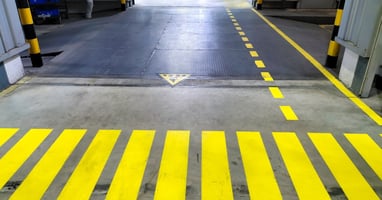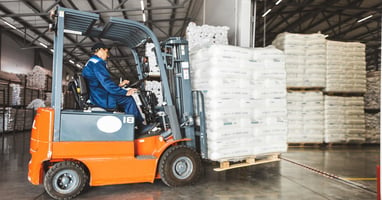Heavy machinery in fast-paced environments create unique risks to employee safety. Luckily, adding...
Tips for Preventing Warehouse Equipment Collisions

A single equipment collision is capable of halting an entire warehouse operation. One misstep, one moment of distraction, and a forklift could accidentally ruin a whole batch of inventory or cause danger to employees.
For warehouses, where constant movement and heavy machinery are the norm, the margin for error is thin. That’s why tackling the challenge of preventing warehouse equipment collisions is more than a safety precaution; it’s an operational imperative. Protect your team and your bottom line with the following expert tips.
Prioritize Collaborative Safety Drills for All Staff Levels
Safety is a team effort. Therefore, ensuring every employee on the warehouse floor understands best practices is critical.
Conduct collaborative safety drills regularly. This will include everyone, from machine operators to administrative personnel, so all team members know how to respond in various hazardous scenarios. These drills reinforce situational awareness, promote teamwork, and establish clear communication pathways during emergency situations.
Revisiting these drills quarterly and incorporating real-life scenarios, such as forklift speed regulation and routine traffic intersection protocols, can keep awareness sharp and prevent accidents before they occur.
Introduce Predictive Maintenance Tools To Pinpoint Wear and Tear
Equipment failure is one of the leading causes of collisions in warehouses. Predictive maintenance tools use Internet of Things (IoT) sensors and advanced algorithms to detect early signs of wear and tear. This early detection can enable you to schedule repairs before failures occur.
For example, software paired with sensors can monitor forklift brakes, tires, or lift mechanisms for performance issues. Managers can leverage these insights to create maintenance schedules that minimize risk and eliminate frequent breakdowns that might compromise safety.
Utilize Zoned Alert Systems for Enhanced Area Awareness
Every warehouse has areas prone to heavy equipment traffic. Think loading docks, cross-aisles, or storage zones. Zoned alert systems, including tools like proximity forklift alarms, can help enhance safety in these high-risk areas. These systems detect when equipment or workers enter designated zones and immediately trigger visual or audio alerts.
Proximity forklift alarms play a particularly important role, warning operators and pedestrians of potential collisions before they happen. By combining these tools with floor signage or digital mapping technology, warehouses can maintain high levels of area awareness.

Incentivize Proactive Reporting of Near-Miss Incidents
Many safety concerns can be addressed long before they escalate to full-scale accidents. Encouraging proactive reporting of near-miss incidents can provide critical insight into potential risks.
Create an anonymous reporting system that allows employees to document unsafe equipment maneuvers or hazardous workplace scenarios without fear of reprimand. To encourage engagement, incentivize employees with small rewards, such as gift cards or recognition programs, for contributing valuable safety insights.
Customize Equipment Modifications for Specific Operational Needs
Standardized equipment can lead to inefficiencies or safety risks when it doesn’t fully align with your warehouse’s operational layout. Consider customizing modifications for vehicles like forklifts or conveyors to address these challenges.
For example, adding rear-view cameras or additional lighting to forklifts can improve visibility and overall maneuverability. Tailoring equipment to specific tasks ensures better usability while minimizing operator error. Ultimately, this creates a safer and more productive worksite.
Optimize Shift Management To Avoid Overcrowding Key Areas
Overcrowded warehouses increase the chances of collisions, especially during shift overlaps. By staggering schedules or creating designated loading and unloading times, you can better distribute traffic flow throughout the day.
Furthermore, maintain a clear roster of equipment operators to avoid unnecessary congestion in key areas. Real-time workforce monitoring software can simplify this process and help ensure optimal staffing at all times.
Develop Visual Cues Tailored to High-Traffic Zones
Visual cues, such as floor markings, laser/LED walkways, or virtual signage, act as constant reminders for operators and workers to maintain awareness in high-traffic zones. Use color coding to designate different areas—for example, red for hazardous zones or green for pedestrian-safe zones.
Installing LED floor projectors near heavy equipment to create dynamic hazard zones that move with the vehicle can further improve safety. These cues act as an extra set of eyes on the ground, reducing the likelihood of accidents.
Incorporate Real-Time Communication Tools Between Operators
Clear, real-time communication between equipment operators is vital in preventing collisions. Equip operators with radio headsets or vehicle-mounted communication devices to streamline interaction and reduce response time to potential hazards.
AI-powered communication enhancements, such as voice recognition, can further prevent misunderstandings or delays during high-pressure tasks. Transparent communication fosters better decision-making, especially when multiple operators collaborate in tight spaces.
Enforce a No-Distraction Policy for Workers
Distractions in the workplace significantly increase the likelihood of accidents. Enforcing a strict no-distraction policy minimizes risks by ensuring that workers remain focused on their immediate tasks and surroundings. This policy should explicitly prohibit the use of personal devices while on duty and emphasize full attention during equipment operation.
By eliminating distractions, operators are better able to anticipate and respond to sudden changes, such as the movement of nearby vehicles or workers. Clear guidelines and consistent enforcement are critical to the success of such a policy.

Elevate Safety Standards Through Transparent Leadership Commitment
Safety initiatives thrive under visible support from leadership. Communicate your commitment to safety through regular team meetings, updated protocols, and management walkarounds.
When team members witness leadership prioritizing safety, whether through investment in new tools or active participation during drills, they’re more likely to follow suit. Leaders set the tone for a safety-first culture.
Map Out Seasonal Adjustments to Traffic Patterns During Peak Times
During peak operational periods, such as the holiday season, warehouses often undergo increased traffic. Take steps to adjust traffic patterns preemptively by analyzing historical data.
Implement dedicated lanes for specific tasks, such as inbound deliveries or packing station access, to streamline workflows. Temporary traffic signage and the employee training sessions mentioned above can prepare the workforce for these seasonal changes while avoiding crowding or confusion.
Foster Individual Accountability With Personalized Safety Goals
While safety is a team effort, workers still need to be held accountable individually to keep the workforce safe as a whole. Establish personalized safety goals for each employee based on their responsibilities and track their progress.
Whether it’s achieving incident-free hours or consistent performance on safety checklists, individual recognition helps foster a sense of ownership. Offer small rewards for meeting these milestones to further incentivize engagement.
Collisions are preventable events that can reflect the overall health of a warehouse operation. Preventing warehouse equipment collisions means keeping workflow efficient, morale up, and safety at the highest standard. This will require more than just awareness. Take action and commit to the expert strategies above to protect your team and operations.
Logimate is here to make your warehouse safer! With our proximity sensors and LED projectors, you can create a modern and secure working environment for your forklift drivers, operators, and other employees. Make safety the foundation of your warehouse today because the cost of inaction is far too high.




